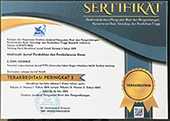Interkoneksi Sains dalam Pembentukan Karakter Ilmiah Peserta Didik di Madrasah
Abstract
Keywords
Full Text:
PDFReferences
Baharuddin dan Moh. Makin. (2007). Pendidikan humanistic (Konsep, teori, dan aplikasi praksis dalam dunia pendidikan). Yogyakarta: Ar-Ruzz Media, 2007.
Bakar, Osman. (2008). Tauhid dan Sains Perspektif Islam tentang Agama dan Sains, Bandung: Pustaka Hidayah.
Depdiknas. (2007). Panduan Pengembangan Pembelajaran IPA Terpadu. Jakarta: Puskur, Balitbang Depdiknas.
Fatonah, Siti dan Zuhdan Kun Prasetyo. (2014) Pembelajaran Sains. Yogyakarta: Ombak.
Hakim, Abdul dan Sudarnoto. (2003). Islam dan Konstruksi Ilmu Peradaban dan Humaniora, UIN Press.
Jasien, Maskori. (2010). Ilmu Alamiah Dasar. Jakarta: Raja Grafindo Persada.
Kartanegara, Mulyadhi. (2000). Mozaik Khazanah Islam (Bunga rampai dari Chicago). Jakarta: Paramadina.
Prabowo. (2010). Konsep Pembelajaran Terpadu: Konsep, strategi, dan implementasinya dalam KTSP. Jakarta: Bumi Aksara.
Sadar, M. Husain. (1984). “Science and Islam: Is There A Conflict?”, dalam Ziauddin Sardar (ed.), The Touch of Midas Science, Values and Environment in Islam and the West, India: The Other India Press.
Samatowa, Usman. (2011). Pembelajaran IPA di Sekolah Dasar. Jakarta: Indeks Permata Puri Media.
Standar Isi Permendiknas No.22 tahun 2006.
Susanto, Ahmad. Teori Belajar dan Pembelajaran di Sekolah Dasar. Jakarta: Kencana Prenadamedia Group.
Usa, Muslih dan Aden Wijaya. (1987). Pendidikan Islam dalam Peradaban Industrial. Yogyakarta: Aditia Media.
Vardiansyah, Dani. (2008). Filsafat Ilmu Komunikasi. Jakarta: Indeks.
Winaputra, Udin. (1992). Strategi Belajar Mengajar IPA. Jakarta: Universitas Terbuka (UT).
DOI: https://doi.org/10.18860/madrasah.v10i2.5377
Copyright (c) 2018 Madrasah: Jurnal Pendidikan dan Pembelajaran Dasar

This work is licensed under a Creative Commons Attribution-NonCommercial-ShareAlike 4.0 International License.





